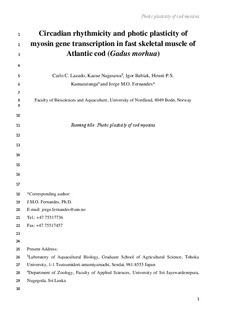Circadian rhythmicity and photic plasticity of myosin gene transcription in fast skeletal muscle of Atlantic cod (Gadus morhua)
Lazado, Carlo Cabacang; Nagasawa, Kazue; Babiak, Igor; Kumaratunga, Palawinnage Hiruni Senari; Fernandes, Jorge M.O.
Journal article, Peer reviewed
Permanent lenke
http://hdl.handle.net/11250/279346Utgivelsesdato
2014Metadata
Vis full innførselSamlinger
Originalversjon
Lazado, C.C., Nagasawa, K., Babiak, I., Kumaratunga, P.H.S. & Fernandes, J.M.O. (2014). Circadian rhythmicity and photic plasticity of myosin gene transcription in fast skeletal muscle of Atlantic cod (Gadus morhua). Marine Genomics, 18(A), 21-29. doi: 10.1016/j.margen.2014.04.011Sammendrag
The circadian rhythm is a fundamental adaptive mechanism to the daily environmental changes experienced by many organisms, including fish. Myosins constitute a large family of contractile proteins that are essential functional components of skeletal muscle. They are known to display thermal plasticity but the influence of light on myosin expression remains to be investigated in fish. In the present study, we have examined the circadian rhythmicity and photoperiodic plasticity of myosin gene transcription in Atlantic cod (Gadus morhua) fast skeletal muscle. In silico mining of the Atlantic cod genome resulted in the identification of 76 myosins representing different classes, many of which were hitherto uncharacterized. Among the 23 skeletal muscle-expressed myosin genes, myh_tc, myh_n1, myh_n4, myo18a_2, and myo18b_2 displayed circadian rhythmicity and contained several circadian-related transcription factor binding sites (Creb, Mef2 and E-box motifs) within their putative promoter regions. Also, the circadian expression of these 5 myosins strongly correlated with the transcription pattern of clock genes in fast skeletal muscle. Under ex vivo conditions, myosin transcript levels lost their circadian rhythmicity. Nonetheless, different photoperiod regimes influenced the mRNA levels of myh_n4, myo18a_2 and myo18b_2 in fast skeletal muscle explants. Photoperiod manipulation in Atlantic cod juveniles revealed that continuous light significantly elevated mRNA levels of several myosins in fast skeletal muscle when compared to natural photoperiod. The circadian rhythmicity observed in some fast skeletal muscle myosin genes suggests that they may be under circadian clock regulation. In addition, the influence of photoperiod on their expression implies that myosins may be involved in the photic plasticity of muscle growth observed in Atlantic cod.
